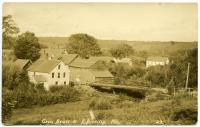
East Dixfield Post Office and General Store, Wilton, ca. 1914
Dixfield Historical Society
EAST DIXFIELD
The Next Section to be Settled
East Dixfield is a village within Dixfield that is divided by a common county line running through it. Years ago, one of the homes was built with the county line running through the livingroom. Whenever East Dixfield is mentioned, people think of the village as a whole, even though some residents live in the Town of Wilton (Franklin County), while others live in Dixfield (Oxford County). The East Dixfield Post Office has been moved four times--twice to the Dixfield side of Main Street and twice to the Wilton side where it is located in 2013.
The rolling hills of East Dixfield still resonate today with the names of the early settlers such as Severy, Morse, Hannaford, Walker, Hiscock, and Science Hill. Most are named after homesteaders who settled the hilly land. Science Hill, however, was so-called because of the many creative inventors who seemed to attract patents like honey attracts bees. Tradition holds that Aaron Severy, who felled the first tree in the area, learned that he had a new neighbor only by hearing the sound of an axe on a distant hill. It was Osgood Walker, and the hill became named for this family.
Some of the inventors living in the Town of Dixfield during its early history include Leonard Norcross and his Diving Armour, patented June 14, 1834; John J. Towle and his Combined Foot-Warmer and Lantern, patented June 8, 1880; and Henry O. Stanley and his Rangeley Spinner, late 1800s. From East Dixfield the Apple Cutter, Patented October 20, 1857 and the Apple Corer, Patented April 6, 1869, were designed by Nathaniel Thomas. R.S. Morse applied for a patent for a “Cabbage Slicer” and received one on May 24, 1870 for his “favorite” Washtub Agitator. Our ancestors were industrious with true American entrepreneurial spirit!
Apples were viewed as the crop that would allow East Dixfield farmers to thrive and many farmers planted apple trees. East Dixfield became known by its quantity of apples dried annually, led by Cyrus and Warren Severy and the inventions of Nathaniel Thomas. The Coolidges, Halls, Lelands, Kings, Wheelwrights and Townsends were among the families living there. Ruth Kidder wrote: The “Year With No Summer-1816" caused the men to hoe and harvest with mittens on or the frost stuck their hands to the tools. Just a little wheat was raised and a few potatoes. Many stories have been told about that difficult year. It snowed sometime during every month.

View of Seven Mile Stream, East Dixfield, ca.1910
Dixfield Historical Society
Today, East Dixfield is truly a sleepy, little hamlet within the Town of Dixfield. Three cemeteries are located there: the Severy Hill Cemetery, Eddy Cemetery (an old family plot) and the Science Hill Cemetery. These cemeteries honor many war veterans and some of our founding ancestors. Although Science Hill and Eddy Cemeteries require a four-wheeler ATV to gain access, during the summer of 2012, an Eagle Scout project refurbished the Science Hill Cemetery by building new steps, removing brush, and uprighting and cleaning old stones. The town was very grateful for the many hours volunteers spent on this old piece of history.
To negotiate the heavily forested hills, roads were built to accommodate a stage line that connected East Dixfield with Dixfield Common, thence to the Village. Horses pulled the stage over roads that are closed today. Bowery Corner, an old intersection connecting various roads in the Severy Hill area, put up horses overnight en route to Dixfield Village, and a tavern and school were once located there. In 1860 the folks on Severy Hill built a huge cart body and put it on four cart-wheels with 12 yoke of oxen, with all the people they could pile on to it, and drove to Dixfield Village. Jonathan Waite was at the head of it when the cart arrived in the Village. Jonas T. Severy ran the hotel and furnished the rum and raffled off a white horse at $1/ticket. It was said that a hot time in the old town was had that night.
East Dixfield’s history has been long-forgotten by most until recent years with the addition of new people from a new generation who have shown a great interest in this vital part of the town’s history. The people in this section of town continue to enlighten us with many old stories that are once again making their mark–just as the many inventors of Science Hill did so long ago.